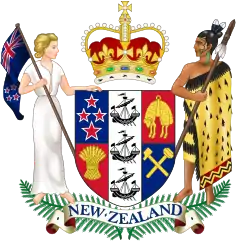Ministers in the New Zealand Government
Ministers, in the New Zealand Government, are members of Parliament (MPs) who hold ministerial warrants from the Crown to perform certain functions of government. This includes formulating and implementing policies and advising the governor-general. Ministers collectively make up the executive branch of the New Zealand state. The governor-general is obliged to follow the advice of the prime minister on the appointment and dismissal of ministers.
.jpg.webp)
 |
|---|
| This article is part of a series on the politics and government of New Zealand |
| Constitution |
|
|
All ministers serve concurrently as councillors of the Executive Council of New Zealand. These executives are also formally titled "ministers of the Crown",[1] as in other Commonwealth realms.
Appointment and dismissal
The appointment of an MP as a minister is formally made by the governor-general, who must sign a ministerial warrant before it officially comes into effect.[2] The governor-general appoints the prime minister (head of government) on the basis of whether they are able to command the confidence of Parliament. The prime minister will advise the governor-general on the appointment or dismissal of other ministers.[3] The first appointments are made whenever a new government takes office, and thereafter whenever a vacancy arises (due to a minister being dismissed or resigning). Each minister takes an oath (or affirmation) of office.[note 2][4]
The recommendations that the prime minister chooses to give are theoretically their own affair, but the political party (or parties) behind them will almost certainly have views on the matter, and most recommendations are made only after negotiation and bargaining. Different parties have different mechanisms for this – the Labour Party, for example, has provision for its parliamentary caucus to select ministers, while the process of portfolio allocation remains with the Labour prime minister.[5]
Responsibilities and powers
The formal powers of the executive are exercised through the Executive Council, which consists of all ministers, and is headed by the governor-general. When the Executive Council resolves to issue an order, and the order is signed by the governor-general, it becomes legally binding.[6]
At the same time as they are appointed to the Executive Council, a minister is generally charged with supervising a particular aspect of the government's activities – known as a "portfolio"[3] – such as the provision of health services (Minister of Health) or the upkeep of law enforcement (Minister of Police).[7] A minister is also responsible for a corresponding public sector organisation, usually known as a department or ministry.[7] Sometimes, an MP may be appointed as a minister without being given any specific role – in which case he or she is described as a minister without portfolio. Such appointments have become rare today, although sometimes an MP may be appointed to a sinecure portfolio such as "Minister of State" for similar purposes.[8]
Individual ministerial responsibility is a constitutional convention that a minister is ultimately responsible for the decisions and actions (and the consequences that follow) of individuals and organisations for which they have ministerial responsibility.[3] Individual ministerial responsibility is not the same as cabinet collective responsibility, which states members of Cabinet must approve publicly of its collective decisions or resign.[9]
History
Originally, the Executive Council functioned as an advisory group to the Governor, and ministerial functions were performed by appointed officials, not politicians. The various "ministers" serving on the Council, such as the Colonial Secretary (Andrew Sinclair since 1844) and the Colonial Treasurer (Alexander Shepherd since 1842), reported to the Governor.[10] When Parliament was established, however, many believed that they would soon replace these appointed officials, with ministerial positions being given to members of Parliament instead. The Acting Governor, Robert Wynyard, did not agree, however, saying that the levers of government could not be turned over to Parliament without approval from Britain. The issue was controversial, and ended with the Acting Governor attempting (with only partial success) to suspend the 1st New Zealand Parliament.[11]
Later, in the 2nd New Zealand Parliament, Parliament was victorious, and the first political ministers were appointed in the 1856 Sewell Ministry. Henry Sewell became Colonial Secretary, Dillon Bell became Colonial Treasurer, Frederick Whitaker became Attorney-General, and Henry Tancred became a minister without portfolio. Since then, all ministers have been appointed from among the ranks of Parliament.[12]
Later, Parliament made further gains, with the convention being established that the governor-general's actions in the Executive Council were bound by the advice that ministers gave. Today, the Executive Council is not used for deliberation—rather, Cabinet is the forum for debate. Cabinet is a separate meeting of most (but usually not all) government ministers, and formally presents proposals to the whole Executive Council only when a decision has already been reached.
Prominent ministerial positions
- Prime Minister
- Deputy Prime Minister
- Minister of Agriculture
- Minister of Conservation
- Minister of Defence
- Minister of Education
- Minister of Finance
- Minister of Foreign Affairs
- Minister of Health
- Minister of Internal Affairs
- Minister of Justice
- Minister for Māori Development
- Minister of Social Development
- Attorney-General
Current portfolios
As of 2020 the following ministerial portfolios exist.[13] Many ministers hold multiple positions.
Notes
- Showing from left to right: Adam Hamilton; Walter Nash, Minister of Finance; British politician Duff Cooper; Prime Minister Peter Fraser; Dan Sullivan, Minister of Supply; Fred Jones, Minister of Defence; Gordon Coates, Minister of Armed Forces and War Co-ordination.
- Historically most ministers swore an oath on the Bible, but now most choose to affirm their intent, without reference to God.
- In the front row are (left to right): Alfred Ransom, Gordon Coates, Prime Minister George Forbes, William Downie Stewart Sr, Āpirana Ngata, and Alexander Young. In the back row are (left to right): David Jones, John Cobbe, Adam Hamilton, and Robert Masters.
References
Citations
- "Ministers of the Crown: Appointment, Role, and Conduct". Cabinet Manual. The Department of the Prime Minister and Cabinet. 24 June 2017. Retrieved 4 May 2018.
- Eichbaum, Chris. "Cabinet government – What is cabinet?". Te Ara: The Encyclopedia of New Zealand. Retrieved 14 March 2020.
- Eichbaum, Chris. "Cabinet government – Ministers and prime ministers in cabinet". Te Ara: The Encyclopedia of New Zealand. Retrieved 20 November 2018.
- Young, Audrey (30 June 2000). "Only two choose to swear on 'Bible'". The New Zealand Herald. Retrieved 3 April 2020.
- Dowding, Keith; Dumont, Patrick (2014). The Selection of Ministers around the World. Routledge. p. 27. ISBN 9781317634454. Retrieved 5 September 2019.
- "Sovereign, Governor-General, and Executive Council: Meetings of the Executive Council". Cabinet Manual. The Department of the Prime Minister and Cabinet. 23 June 2017.
- "Ministerial portfolios". The Department of the Prime Minister and Cabinet. Retrieved 20 November 2018.
- For example: "Keith Holyoake". NZHistory. Ministry for Culture and Heritage. Retrieved 20 November 2018.
- Eichbaum, Chris. "Cabinet government – Collective responsibility". Te Ara: The Encyclopedia of New Zealand. Retrieved 20 November 2018.
- Scholefield 1950, p. 27.
- "General Robert Henry Wynyard". The Cyclopedia of New Zealand. Victoria University of Wellington. Retrieved 6 September 2019.
- Scholefield 1950, p. 31.
- "Portfolios". Beehive.govt.nz. New Zealand Government. Retrieved 16 May 2020.
Sources
- Scholefield, Guy (1950) [1st ed. published 1913]. New Zealand Parliamentary Record, 1840–1949 (3rd ed.). Wellington, New Zealand: Govt. Printer.

